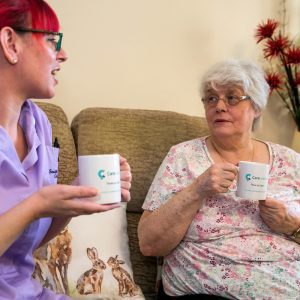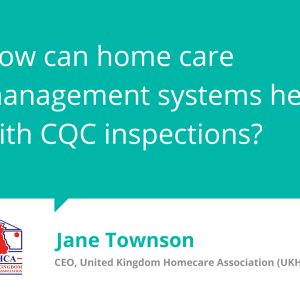The prospect of a regulatory inspection can be daunting for even the most organised of home care providers. In the past this could signal a mad rush to ensure that paperwork was all up-to-date and in place. But with fully integrated home care software, so long as your processes past muster, inspections should not be such a worry. Here’s our checklist of what to have in place for a smooth inspection.
Digital documentation and compliance
The social care industry is undergoing a rapid transformation adopting innovative technologies and digital processes to improve operational efficiencies, ensure compliance and to elevate the quality of care delivery. From digital documentation to staff training and data analysis leveraging technology can significantly boost service efficiency, safety and compliance.
Ensuring compliance and readiness
Regulatory organisations now advocate for Digital Social Care Records (DSCR) to efficiently demonstrate quality care. Digital solutions offer accurate, accessible and inspection-ready documentation. Customised software has become essential in care management providing automated alerts for audits, client reviews, training renewals and policy updates. These alerts help prevent compliance lapses and ensure services remain on track. Automated notifications can be tailored to flag upcoming regulatory events or deadlines minimising the risk of non-compliance to regulations and legislation.
Getting started with compliance
Embarking on the journey of compliance may initially appear daunting but it doesn’t have to be. Gaining a clear understanding of the complexities of legislation, regulations and expected standards of care is vital from both a service delivery and service user perspective. This knowledge forms a crucial foundation for effective leadership and compliance in these areas.
Establishing a comprehensive framework for quality monitoring and regulatory compliance is essential for your organisation as it directly influences outcomes. This process begins with the implementation of OKRs (Objectives and Key Results). This goal-setting framework enhances communication and aids in the attainment of strategic objectives. It establishes overarching directional goals while the key results offer specific measurable outcomes that allow for effective progress tracking.
Preparing for inspection
Regulators across the UK have a shared mission, they want to see providers delivering safe and high quality care, treatment and support. It’s vital to ensure that your team is prepared for evaluation and inspection. It is essential that they are empowered to identify existing service weaknesses while also being encouraged to showcase the strengths and achievements of the service. This process should be ongoing and part of the regular monitoring of your service.
To effectively prepare for assessments and inspections, it is crucial to establish clear criteria and familiarise yourself with the regulatory framework. A prime example of regulatory guidance is the CQC Single Assessment Framework, which outlines five key questions supported by specific quality statements. Gaining a thorough understanding of these components will help ensure compliance and enhance the quality of care provided. Additionally, Care Inspectorate Scotland and Care Inspectorate Wales have similar inspection frameworks with an emphasis on self-evaluation of services.
Your framework should accurately represent your unique service drawing from the wealth of information at your disposal as evidence. Discover CareLineLive’s comprehensive resources created to showcase how our all-in-one software features can effectively support regulatory compliance.
See links to effective evidence collection.
To ensure effective evidence collection I recommend creating digital folders specifically for the overarching criteria such as the CQC key questions. Within these main folders establish subfolders where you can systematically add evidence corresponding to each quality statement. Staying organised and proactive in your evidence collection is essential to being ‘inspection ready’ at all times. Remember to showcase your achievements, this can go under the radar! Your regulator wants to hear about what is going well and the results of service improvements on staff and service users.
Review inspection reports from comparable companies to uncover opportunities for improvement. This thorough approach merging strategic goal-setting, quality assurance, risk management and continuous improvement will propel your organisation toward excellence and compliance.
Mock inspections can be especially effective. Simulate inspections to evaluate your service highlighting strengths, and identifying weaknesses. Engaging external consultants can provide objective assessments and valuable insights.
Streamlining communication and collaboration
Technology can centralise and streamline communication with staff and stakeholders. Digital platforms like CareLineLive manage staff records, ensuring accuracy and compliance. Introducing regulatory champions can certainly promote compliance and can be a basis for excelling in best practice. Here are some helpful tips for you:
- Develop interactive training sessions and involve staff in service improvement projects to cultivate a sense of ownership and innovation
- Centralised resource hubs allow staff to store all policies, procedures and inspection resources in one easily accessible location
- Real-time messaging platforms allow teams to quickly share updates, reminders or tasks related to inspection preparation
- Digital portals allows users to submit evidence to regulators more efficiently and receive real-time updates on submission statuses
Improving risk management
Digital tools enable real-time risk logging and reporting. CareLineLive’s management portal demonstrates a robust reporting feature together with a concerns and incident risk management feature allowing services providers to monitor and showcase the safety of their services during audits, assessments and inspections. Our carer companion app empowers staff to effectively communicate and document day to day activities and to report any concerns and incidents in real-time. This vital information is critical for evidencing how well-led, effective and responsive your service is.
Feedback systems
Feedback plays a vital role for leaders in gaining a comprehensive understanding of their services. It is essential for all stakeholders to have a voice, ensuring that insights gathered from the service are utilised for enhancement and to highlight the commendable efforts taking place within the organisation.
Feedback automation empowers users to efficiently gather and analyse feedback from service users and their families through various channels, including apps and surveys. This process is instrumental in enhancing the quality of care, ensuring safety and fostering continuous learning and improvement.
Conducting data-driven audits
- Regular audits utilising customised frameworks help organisations identify areas for improvement. Analysing data from reviews allows care providers to enhance person-centred practices and adjust staff training needs
- Auditing includes:
- Regularly review care plans, care notes and electronic medication administration records to ensure accuracy and address any issues
- Establish clear timelines that illustrate the client’s journey
- Establish clear staff monitoring processes
- Annual returns and self-evaluation documents should be viewed as dynamic resources that require regular updates to effectively reflect ongoing service improvements. By maintaining these working documents you can save valuable time and resources ensuring that you are always prepared for inspections
Continuous training and self-evaluation
Encourage self-evaluation, reflective practice and internal audits to foster a culture of continuous improvement. Documenting and sharing positive client experiences and case studies can further showcase service quality during inspections.
By leveraging technology for digital documentation, compliance tracking and staff development, care providers can remain inspection-ready and maintain high-quality services. Staying informed about regulatory developments and adopting innovative solutions enables social care providers to drive continuous improvement, ensuring a safe and compliant environment for both staff and service users.
Stay ahead by embracing technology, fostering collaboration, and committing to continuous learning. Explore CareLineLive’s features here. The platform is designed to help you efficiently meet compliance requirements.
Showcasing a well-led service
The future of home care is deeply intertwined with the essential balance of responsibility, innovation and influence. By wholeheartedly embracing sustainability and leveraging management software like CareLineLive care agencies have the opportunity to create a future where strong operational practices work hand in hand with positive environmental outcomes. This approach not only enhances the well-being of clients but also contributes to the health of our planet, fostering a sense of care and responsibility for generations to come.
A well-led service must prioritise sustainability across the service to comply with regulations. Leaders must provide evidence to support not only environmental sustainability but also service sustainability.
Here’s some points to address:
- Environmental responsibility: Home care providers are increasingly dedicated to minimising their carbon footprint by prioritising energy efficiency, reducing waste and utilising eco-friendly products
- Economic efficiency: Sustainable practices not only lead to cost savings but also enhance operational efficiency thereby ensuring the financial stability of care agencies
- Quality of care: Sustainability initiatives can significantly enhance the quality of care by creating healthier environments for both clients and care staff
- Technology integration: The implementation of software solutions improves resource allocation, streamlines operations and reduces unnecessary travel
- Staff education: Educating care staff on sustainable practices empowers them to act as ambassadors for environmentally conscious care
- Community engagement: Sustainable home care highlights the importance of collaborating with local communities while raising awareness of environmental issues
- Regulatory compliance: Care providers are increasingly required to demonstrate their commitment to sustainability, a demand reflected in the assessment criteria established by regulatory organisations such as the Care Quality Commission (CQC)
Explore CareLineLive’s resources to discover how the platform can enhance sustainability efforts. Book a demo here today!
Advice from other providers
Here’s Debra Robey, Director of Crescent Homecare, on how CareLineLive helps them maintain an Outstanding rating.
Here’s Joanne Davies, Director of Care with My Care My Home on how CareLineLive helps with regulatory compliance.




